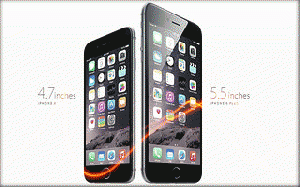Please check out what Dr. Joel Moskowitz reports about the Apple's iPhone 6 and iPhone 6 Plus SAR levels:
iPhone 6 SAR: Radiation Levels & Separation Distance
What are the SAR levels for Apple's iPhone
6 and iPhone 6 Plus?
What is the minimum body separation distance? How should the consumer use this information?
For both Apple iPhone 6 models, the SAR level for the head is
1.18. When using a body-worn accessory to keep the phone five millimeters from
the body, the SAR level is 1.18 for the iPhone 6 and 1.19 for the iPhone 6
Plus. (1, 2) Thus, the minimum separation distance that the phones should be
kept from the body is approximately two-tenths of an inch (i.e., 5 millimeters).
Like most cell phones, both new iPhone models have several
transmitters that can simultaneously emit microwave radiation, which includes cellular,
Wi-Fi, and Bluetooth radiation. When all these transmitters are turned on, the
SAR value is 1.58 for the iPhone 6 and 1.59 for the iPhone 6 Plus. (1, 2) These
levels are very close to the legal limit which is 1.60. To reduce exposure to
microwave radiation, turn off any transmitters not in use.
What
does this information mean to the consumer?
The Federal Communications Commission (FCC) requires all
cell phone models to be tested for their Specific Absorption Rate or SAR. The
SAR is a measure of the maximum amount of microwave radiation absorbed by the
head or the body. It is measured in a laboratory using an artificial model of a
large adult male with different fluids to simulate human tissue. The SAR, which
is measured in watts per kilogram, represents the maximum amount of energy
absorbed in any one gram of tissue in the test model. Phones sold in the U.S.
typically range in SAR values from about 0.20 up to the 1.60 legal limit. (3,
4)
The SAR test, adopted in 1996 by the FCC, was criticized by
the U.S. Government Accountability Office in 2012. (5) The test does not reflect
those who currently use cell phones, nor does it correspond to the way people
use them. Today many children are cell phone users -- the child's brain absorbs
twice the radiation as the adult's brain. Moreover, the artificial head does
not contain any metal (e.g., dental fillings, earrings, or eyeglass frames) which
could increase the radiation absorption beyond what the laboratory-generated SAR
reflects. (5)
The FCC assumes that consumers will carry their cell phones
in a manufacturer-approved holder that keeps the phone a minimum distance from
the body. However, people do not reliably keep their phone away from their body
in a cell phone holder. For the SAR test, the FCC allows the manufacturer to choose
the separation distance between the cell phone and the test model as long as
consumers are informed about the minimum distance tested. Few consumers are
aware of the manufacturer's recommended minimum body separation from their cell
phone because this information is often difficult to find. Thus, most consumers
are in the dark about precautions they can take to keep their exposure to
microwave radiation below the legal limit.
To ensure that the cell phone does not exceed the legal
limit, consumers should never keep their cell phone in their pockets or next to
their skin. The cell phone is not tested directly against the body because most
cell phones would fail the SAR test as the radiation absorption increases dramatically
when the cell phone is close to the body.
Is
the legal limit sufficient to protect the cell phone user's health?
U.S. Federal policies and practices lead the public to
believe that all legally-marketed cell phones are safe, and that a cell phone's
SAR doesn't matter as long as it meets the legal limit: 1.6 watts per kilogram.
(3, 4)
The Environmental Working Group and other scientific experts
point out that the SAR only measures the maximum microwave absorption from cell
phone use that perfectly matches laboratory conditions. The SAR is not a good
indicator of one's cumulative microwave exposure under natural conditions. The evidence suggests that how one uses the
phone (e.g., hands-free) and one's cell phone carrier actually matters a great
deal more than the phone's SAR level. (4, 6, 7)
The SAR standard was developed to protect users only from
the acute effects of the heat generated by microwave radiation (i.e., the
thermal effect). (5) The SAR limit
does not protect users from non-thermal effects of cell phone radiation.
Yet, hundreds of laboratory studies with animals and cell
samples have found deleterious biologic effects from short-term exposure to low
intensity cell phone radiation, including development of stress proteins,
micronuclei, free radicals, DNA breakage, and sperm damage. (8) Human studies
have also found that brief exposure to cell phone radiation alters brain
activity and can open the blood-brain barrier which could enable any chemical
toxins in the blood system to penetrate the brain. (9)
Major studies with humans have found increased cancer risk,
including a three-fold increase in brain cancer among those who used wireless
phones (cell phones and cordless phones) for 25 or more years. (10) Largely based upon this research, the World
Health Organization in 2011 declared radiofrequency radiation possibly
carcinogenic in humans (Group 2B). (11)
Other risks from cell phone use include reproductive health
damage and male infertility, and neurological disorders (e.g., impaired
cognitive functioning, headaches and migraines, and attention
deficit/hyperactivity disorder). (12, 13)
Based upon the weight of the evidence from several decades
of research including thousands of peer-reviewed published studies, many experts
worldwide have signed declarations calling upon government to adopt stronger
radiation standards to protect consumers from low intensity, non-thermal
exposures from radiation associated with wireless communications, and to alert
consumers about how to reduce their risk of harm. (14 -16)
For tips on how to reduce exposure to wireless radiation,
see Electromagnetic Radiation Safety (
http://www.saferemr.com).
(17)
Joel M.
Moskowitz, Ph.D.
School of
Public Health
University
of California, Berkeley
References
(1) Apple, Inc. "BCG-E2816A by Apple Inc. for Cellular Phone
with Bluetooth and WLAN Radios." Report No. 14U17673-S1C submitted to FCC. Aug 15, 2014.
iPhone 6 SAR Levels (in watts per
kilogram)
Head = 1.18
Body-worn Accessory = 1.18
Wireless Router (Hotspot) = 1.18
Simultaneous Transmission (Head) = 1.51
Simultaneous Transmission (Body) = 1.58
(2) Apple, Inc. "BCG-E2817A
by Apple Inc. for Cellular Phone with Bluetooth and WLAN Radios." Report No.
14U17676-S1C submitted to FCC. Aug 15, 2014.
iPhone 6 Plus SAR Levels (in watts
per kilogram)
Head = 1.18
Body-worn Accessory = 1.19
Wireless Router (Hotspot) = 1.19
Simultaneous Transmission (Head) = 1.59
Simultaneous Transmission (Body) = 1.54
(8) Giuliani L. Soffritti M. Non-thermal effects and
mechanisms of interaction between electromagnetic fields and living matter.
ICEMS Monograph. Bologna, Italy: National Institute for the Study and Control
of Cancer. 2010.
http://www.icems.eu/papers.htm
(13) Joel Moskowitz. "Cell Phone Use and
Prenatal Exposure to Cell Phone Radiation May Cause Headaches in Children."
http://www.prlog.org/12269207
(17) Joel
Moskowitz. Some Tips to Reduce Your Exposure to Wireless Radiation (one page handout). Undated.
http://www.saferemr.com.
--
October 8, 2014 Update:
My comments:
Apple has
recently posted on its web site the RF exposure information for the
iPhone 6 and iPhone 6 Plus. Cell phone manufacturers are not required by
law to disclose the simultaneous transmission SAR for head and body,
and Apple like most other manufacturers does not report this
information.
The SAR information that I reported above on September 19 was obtained
from the official SAR test reports that Apple filed with the FCC. For
simultaneous transmission, the SAR values (averaged over 1 gram of
tissue) ranged from 1.51 to 1.59 which is close to the legal limit
of 1.60.
The following information has been copied directly from the Apple web site:
iPhone has been tested and meets applicable limits for radio frequency (RF) exposure.
Specific Absorption Rate (SAR) refers to the rate at which the body
absorbs RF energy. The SAR limit is 1.6 watts per kilogram in countries
that set the limit averaged over 1 gram of tissue and 2.0 watts per
kilogram in countries that set the limit averaged over 10 grams of
tissue. During testing, iPhone radios are set to their highest
transmission levels and placed in positions that simulate use against
the head, with no separation, and near the body, with 5mm separation.
Depending on the dimensions of the device, additional SAR limits may apply. To reduce exposure to RF energy, use a hands-free option, such as
the built-in speakerphone, the supplied headphones, or other similar
accessories. Carry iPhone at least 5mm away from your body to ensure
exposure levels remain at or below the as-tested levels. Cases with
metal parts may change the RF performance of the device, including its
compliance with RF exposure guidelines, in a manner that has not been
tested or certified.
Although this device has been tested to determine SAR in each band
of operation, not all bands are available in all areas. Bands are
dependent on your service provider's wireless and roaming networks.
Model
A1549
SAR Limit
Body
Head
SAR Limit
Body
Head
Next Page 1 | 2 | 3 | 4 | 5 | 6
(Note: You can view every article as one long page if you sign up as an Advocate Member, or higher).






